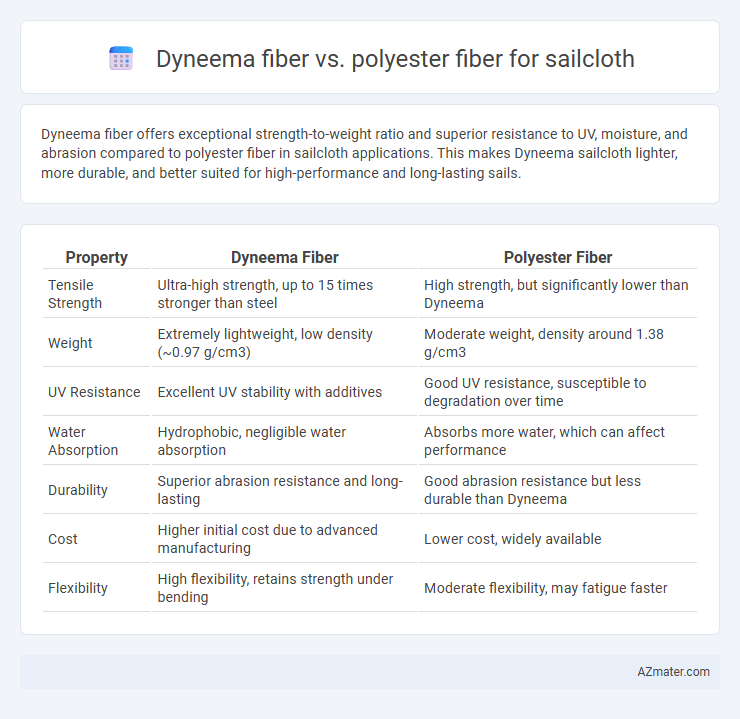Dyneema fiber offers exceptional strength-to-weight ratio and superior resistance to UV, moisture, and abrasion compared to polyester fiber in sailcloth applications. This makes Dyneema sailcloth lighter, more durable, and better suited for high-performance and long-lasting sails.
Table of Comparison
| Property | Dyneema Fiber | Polyester Fiber |
|---|---|---|
| Tensile Strength | Ultra-high strength, up to 15 times stronger than steel | High strength, but significantly lower than Dyneema |
| Weight | Extremely lightweight, low density (~0.97 g/cm3) | Moderate weight, density around 1.38 g/cm3 |
| UV Resistance | Excellent UV stability with additives | Good UV resistance, susceptible to degradation over time |
| Water Absorption | Hydrophobic, negligible water absorption | Absorbs more water, which can affect performance |
| Durability | Superior abrasion resistance and long-lasting | Good abrasion resistance but less durable than Dyneema |
| Cost | Higher initial cost due to advanced manufacturing | Lower cost, widely available |
| Flexibility | High flexibility, retains strength under bending | Moderate flexibility, may fatigue faster |
Introduction to Sailcloth Materials
Dyneema fiber offers exceptional strength-to-weight ratio and superior UV resistance, making it a premium choice for high-performance sailcloth. Polyester fiber remains popular due to its durability, cost-effectiveness, and excellent resistance to stretch and abrasion in various marine conditions. Understanding the distinct mechanical properties and environmental resilience of these fibers is essential for selecting optimal sailcloth materials tailored to specific sailing applications.
Overview of Dyneema Fiber
Dyneema fiber, known for its ultra-high molecular weight polyethylene (UHMWPE) composition, offers exceptional strength-to-weight ratio and superior durability compared to traditional polyester fiber used in sailcloth. It provides enhanced resistance to UV degradation, abrasion, and moisture absorption, making it a preferred material for high-performance sailing applications. Unlike polyester, Dyneema maintains minimal stretch under load, resulting in improved sail shape retention and overall efficiency on the water.
Overview of Polyester Fiber
Polyester fiber, widely used in sailcloth manufacturing, offers exceptional UV resistance, durability, and cost-effectiveness compared to Dyneema fiber. Its high tensile strength and dimensional stability under varying weather conditions make it a preferred choice for cruising sails and recreational boating applications. Unlike Dyneema, polyester retains better stretch resistance and comfort, optimizing overall sail performance and longevity.
Strength Comparison: Dyneema vs Polyester
Dyneema fiber exhibits significantly higher tensile strength than polyester fiber, making it the preferred choice for high-performance sailcloth applications that demand superior durability and resistance to tearing. While polyester offers decent strength and greater elasticity, Dyneema's ultra-high-molecular-weight polyethylene (UHMWPE) structure provides exceptional strength-to-weight ratio and minimal stretch under load. This strength comparison highlights Dyneema's advantage in maintaining sail shape and maximizing speed in competitive sailing conditions.
Durability and Longevity Analysis
Dyneema fiber offers superior durability and longevity for sailcloth compared to polyester due to its exceptional tensile strength and resistance to UV degradation, abrasion, and moisture absorption. Polyester fibers, while more affordable and widely used, tend to degrade faster under prolonged exposure to sunlight and saltwater, resulting in reduced lifespan and increased maintenance. The high-performance characteristics of Dyneema make it ideal for demanding marine environments where extended durability is crucial.
Weight and Flexibility Differences
Dyneema fiber offers significantly lower weight compared to polyester fiber, making it ideal for high-performance sailcloth where reducing overall sail weight is critical. Its superior flexibility allows Dyneema to maintain strength and durability while conforming better to sail shapes, enhancing aerodynamic efficiency. Polyester fiber, although heavier, provides greater stretch resistance but lacks the lightweight and supple characteristics that Dyneema delivers for advanced sailing applications.
UV Resistance and Weather Performance
Dyneema fiber offers superior UV resistance compared to polyester fiber, maintaining strength and flexibility after prolonged sun exposure, which is critical for sailcloth durability. Polyester fiber, while more affordable, tends to degrade faster under harsh UV radiation and weather conditions, leading to reduced lifespan and performance. The exceptional weather resistance of Dyneema ensures better dimensional stability and longevity in marine environments, making it the preferred choice for high-performance sails.
Cost Effectiveness and Availability
Dyneema fiber offers superior strength-to-weight ratio and durability for sailcloth but is significantly more expensive than polyester fiber, making it less cost-effective for budget-conscious applications. Polyester fiber, although heavier and less strong, remains widely available and affordable, providing a practical choice for most recreational and commercial sailing needs. The frequent supply and lower material costs of polyester make it more accessible in global markets, while Dyneema's premium pricing limits its use primarily to high-performance or specialized sails.
Applications in Modern Sailmaking
Dyneema fiber offers exceptional strength-to-weight ratio and UV resistance, making it ideal for high-performance racing sails where durability and reduced stretch are critical. Polyester fiber remains favored for cruising sails due to its cost-effectiveness, good abrasion resistance, and dimensional stability in various weather conditions. Modern sailmaking often combines Dyneema's lightweight properties with polyester's toughness to optimize sail efficiency and longevity.
Conclusion: Choosing the Right Sailcloth Fiber
Dyneema fiber offers exceptional strength-to-weight ratio, superior UV resistance, and minimal stretch, making it ideal for high-performance sailcloth applications where durability and speed are critical. Polyester fiber provides cost-effective abrasion resistance and good dimensional stability, suitable for cruising sails that require reliable longevity and easier maintenance. Selecting the right sailcloth fiber depends on priorities such as budget, performance demands, and environmental exposure, with Dyneema excelling in high-tech racing scenarios while polyester remains a practical choice for everyday sailing.

Infographic: Dyneema fiber vs Polyester fiber for Sailcloth
 azmater.com
azmater.com